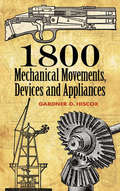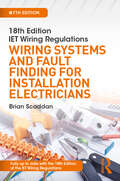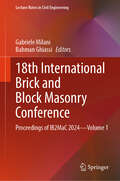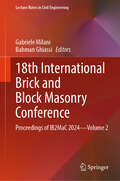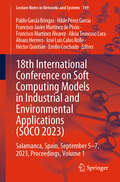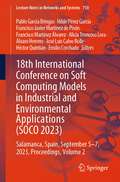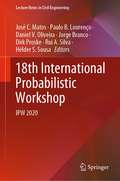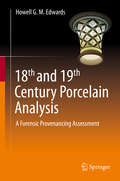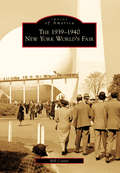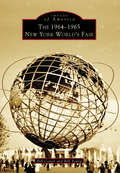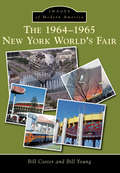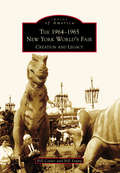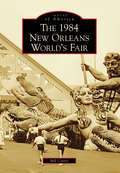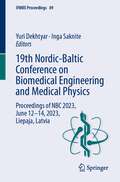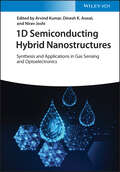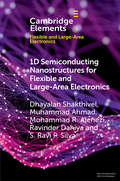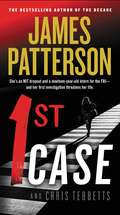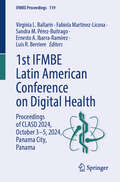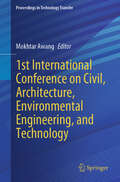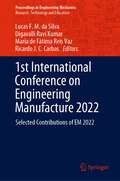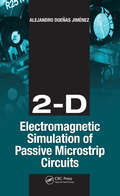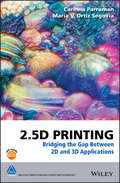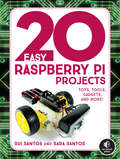- Table View
- List View
1800 Mechanical Movements, Devices and Appliances
by Gardner D. HiscoxA fascinating compendium of early-twentieth-century mechanical devices, this wide-ranging work covers a variety of applications. More than 1,800 engravings—ranging from simple diagrams to detailed cross-sections—illustrate the workings of each item, from simple hooks and levers to complex machinery used in steam, motive, hydraulic, air, and electric power, navigation, gearing, clocks, mining, construction, and more.Compiled as a ready reference for inventors, students of mechanics, artisans, and other workers, this volume features only minimal text. Its true value lies in its wealth of illustrated information, offering the quickest and most satisfactory method of conveying the exact conditions of mechanical action and construction.
18th Edition IET Wiring Regulations: Wiring Systems and Fault Finding for Installation Electricians, 7th ed
by Brian ScaddanThis book deals with an area of practice that many students and non-electricians find particularly challenging. It explains how to interpret circuit diagrams and wiring systems, and outlines the principles of testing before explaining how to apply this knowledge to fault finding in electrical circuits. A handy pocket guide for anybody that needs to be able to trace faults in circuits, whether in domestic, commercial or industrial settings, this book will be extremely useful to electricians, plumbers, heating engineers and intruder alarm installers.
18th International Brick and Block Masonry Conference: Proceedings of IB2MaC 2024—Volume 1 (Lecture Notes in Civil Engineering #613)
by Gabriele Milani Bahman GhiassiThis book highlights the latest advances, innovations, and applications in the field of masonry structures and constructions, as presented by leading international researchers at the 18th International Brick and Block Masonry Conference (IB2MaC), held in Birmingham, UK, on July 21–24, 2024. Conference topics include architecture with masonry, analysis of masonry structures, bricks and blocks, mortars, repair, strengthening and retrofitting, conservation of historical heritage, new construction techniques, seismic engineering, durability and deterioration of materials, energy efficiency, AI, and masonry. The contributions, which were selected by means of a rigorous international peer-review process, present a wealth of exciting ideas that will open novel research directions and foster multidisciplinary collaboration among different specialists.
18th International Brick and Block Masonry Conference: Proceedings of IB2MaC 2024—Volume 2 (Lecture Notes in Civil Engineering #614)
by Gabriele Milani Bahman GhiassiThis book highlights the latest advances, innovations, and applications in the field of masonry structures and constructions, as presented by leading international researchers at the 18th International Brick and Block Masonry Conference (IB2MaC), held in Birmingham, UK, on July 21–24, 2024. Conference topics include architecture with masonry, analysis of masonry structures, bricks and blocks, mortars, repair, strengthening and retrofitting, conservation of historical heritage, new construction techniques, seismic engineering, durability and deterioration of materials, energy efficiency, AI, and masonry. The contributions, which were selected by means of a rigorous international peer-review process, present a wealth of exciting ideas that will open novel research directions and foster multidisciplinary collaboration among different specialists.
18th International Conference on Soft Computing Models in Industrial and Environmental Applications: Salamanca, Spain, September 5–7, 2023, Proceedings, Volume 1 (Lecture Notes in Networks and Systems #749)
by Álvaro Herrero Héctor Quintián Emilio Corchado Francisco Javier Martínez de Pisón Hilde Pérez García Francisco Martínez Álvarez Alicia Troncoso Lora Pablo García Bringas José Luis Calvo RolleThis book of Advances in Intelligent and Soft Computing contains accepted papers presented at SOCO 2023 conference held in the beautiful and historic city of Salamanca (Spain) in September 2023. Soft computing represents a collection or set of computational techniques in machine learning, computer science, and some engineering disciplines, which investigate, simulate, and analyze very complex issues and phenomena. After a through peer-review process, the 18th SOCO 2023 International Program Committee selected 61 papers which are published in these conference proceedings and represents an acceptance rate of 60%. In this relevant edition, a particular emphasis was put on the organization of special sessions. Seven special sessions were organized related to relevant topics such as: Time Series Forecasting in Industrial and Environmental Applications, Technological Foundations and Advanced Applications of Drone Systems, Soft Computing Methods in Manufacturing and Management Systems, Efficiency and Explainability in Machine Learning and Soft Computing, Machine Learning and Computer Vision in Industry 4.0, Genetic and Evolutionary Computation in Real World and Industry, and Soft Computing and Hard Computing for a Data Science Process Model. The selection of papers was extremely rigorous to maintain the high quality of the conference. We want to thank the members of the Program Committees for their hard work during the reviewing process. This is a crucial process for creating a high-standard conference; the SOCO conference would not exist without their help.
18th International Conference on Soft Computing Models in Industrial and Environmental Applications: Salamanca, Spain, September 5–7, 2023, Proceedings, Volume 2 (Lecture Notes in Networks and Systems #750)
by Álvaro Herrero Héctor Quintián Emilio Corchado Francisco Javier Martínez de Pisón Hilde Pérez García Francisco Martínez Álvarez Alicia Troncoso Lora Pablo García Bringas José Luis Calvo RolleThis book of Advances in Intelligent and Soft Computing contains accepted papers presented at SOCO 2023 conference held in the beautiful and historic city of Salamanca (Spain) in September 2023.Soft computing represents a collection or set of computational techniques in machine learning, computer science, and some engineering disciplines, which investigate, simulate, and analyze very complex issues and phenomena.After a through peer-review process, the 18th SOCO 2023 International Program Committee selected 61 papers which are published in these conference proceedings and represents an acceptance rate of 60%. In this relevant edition, a particular emphasis was put on the organization of special sessions. Seven special sessions were organized related to relevant topics such as: Time Series Forecasting in Industrial and Environmental Applications, Technological Foundations and Advanced Applications of Drone Systems, Soft Computing Methods in Manufacturing and Management Systems, Efficiency and Explainability in Machine Learning and Soft Computing, Machine Learning and Computer Vision in Industry 4.0, Genetic and Evolutionary Computation in Real World and Industry, and Soft Computing and Hard Computing for a Data Science Process Model. The selection of papers was extremely rigorous to maintain the high quality of the conference. We want to thank the members of the Program Committees for their hard work during the reviewing process. This is a crucial process for creating a high-standard conference; the SOCO conference would not exist without their help.
18th International Probabilistic Workshop: IPW 2020 (Lecture Notes in Civil Engineering #153)
by Dirk Proske Paulo B. Lourenço Jorge Branco José C. Matos Daniel V. Oliveira Rui A. Silva Hélder S. SousaThis volume presents the proceedings of the 18th International Probabilistic Workshop (IPW), which was held in Guimarães, Portugal in May 2021. Probabilistic methods are currently of crucial importance for research and developments in the field of engineering, which face challenges presented by new materials and technologies and rapidly changing societal needs and values. Contemporary needs related to, for example, performance-based design, service-life design, life-cycle analysis, product optimization, assessment of existing structures and structural robustness give rise to new developments as well as accurate and practically applicable probabilistic and statistical engineering methods to support these developments. These proceedings are a valuable resource for anyone interested in contemporary developments in the field of probabilistic engineering applications.
18th and 19th Century Porcelain Analysis: A Forensic Provenancing Assessment
by Howell G. EdwardsThis book addresses the contributions made by analytical chemistry to the characterisation of 18th and early 19th Century English and Welsh porcelains commencing with the earliest reports of Sir Arthur Church and of Herbert Eccles and Bernard Rackham using chemical digestion techniques and concluding with the most recent instrumental experiments, which together span more than a hundred years of study. From the earliest experiments which required necessarily the sacrifice of significant portions of each specimen, which may already have been damaged , to the latest experiments which needed only microsampling or the non-destructive interrogation of valuable perfect specimens a comprehensive survey is undertaken of more than twenty manufactories of quality porcelains. The correlation is made between the quantitative elemental oxide determinations of the scanning electron microscopic diffraction and Xray fluorescence data and the qualitative molecular spectroscopic Raman data to demonstrate their complementarity and use in the holistic forensic assessment of the origin of the fired procelains ; this will form the groundwork for the adoption of analytical techniques for the attribution of unknown or questionable procelains to their potential source factories . The book will also examine the perception of what constitutes a porcelain and its definitions and examines the assignment of porcelains to types which currently employs the definitions of hard paste , soft paste , hybrid , magnesian and bone china from the conclusions derived from the analytical data and a consideration of the raw materials employed in their manufacturing processes. During the discussion of this analytical evidence several themes and protocols have been established for its utilisation in the potential identification of porcelains and several case studies undertaken for this purpose are cited. The book will be of interest to analytical scientists , to museum ceramics curators and to ceramics historians.
1939-1940 New York World's Fair, The
by Bill CotterAfter enduring 10 harrowing years of the Great Depression, visitors to the 1939-1940 New York World's Fair found welcome relief in the fair's optimistic presentation of the "World of Tomorrow." Pavilions from America's largest corporations and dozens of countries were spread across a 1,216-acre site, showcasing the latest industrial marvels and predictions for the future intermingled with cultural displays from around the world. Well known for its theme structures, the Trylon and Perisphere, the fair was an intriguing mixture of technology, science, architecture, showmanship, and politics. Proclaimed by many as the most memorable world's fair ever held, it predicted wonderful times were ahead for the world even as the clouds of war were gathering. Through vintage photographs, most never published before, The 1939-1940 New York World's Fair recaptures those days when the eyes of the world were on New York and on the future.
1964-1965 New York World's Fair, The: Creation And Legacy (Images of America)
by Bill Cotter Bill YoungThe 1964-1965 New York World's Fair was the largest international exhibition ever built in the United States. More than one hundred fifty pavilions and exhibits spread over six hundred forty-six acres helped the fair live up to its reputation as "the Billion-Dollar Fair." With the cold war in full swing, the fair offered visitors a refreshingly positive view of the future, mirroring the official theme: Peace through Understanding. Guests could travel back in time through a display of full-sized dinosaurs, or look into a future where underwater hotels and flying cars were commonplace. They could enjoy Walt Disney's popular shows, or study actual spacecraft flown in orbit. More than fifty-one million guests visited the fair before it closed forever in 1965. The 1964-1965 New York World's Fair captures the history of this event through vintage photographs, published here for the first time.
1964-1965 New York World's Fair, The: Creation And Legacy (Images of Modern America)
by Bill Cotter Bill YoungAdvertised as the "Billion-Dollar Fair," the 1964-1965 New York World's Fair transformed a sleepy park in the borough of Queens into a fantasy world enjoyed by more than 51 million visitors from around the world. While many countries and states exhibited at the fair, the most memorable pavilions were built by the giants of American industry. Their exhibits took guests backward and forward in time, all the while extolling how marvelous everyday life would be through the use of their products. Many of the techniques used in these shows set the standard for future fairs and theme parks, and the pavilions that housed them remain the most elaborate structures ever built for an American fair. The 1964-1965 New York World's Fair showcases the beauty of this international spectacular through rare color photographs, published here for the first time.
1964-1965 New York World's Fair, The: Creation and Legacy (Images of America)
by Bill Cotter Bill YoungWhen the gates of the 1964-1965 New York World's Fair swung open on April 24, 1964, the first of more than 51 million lucky visitors entered, ready to witness the cutting edge of worldwide technology and progress. Faced with a disappointing lack of foreign participants due to political contention, the fair instead showcased the best of American industry and science. While multimillion-dollar pavilions predicted colonies on the moon and hotels under the ocean, other forecasts, such as the promises of computer technology, have surpassed even the most optimistic predictions of the fair. The 1964-1965 New York World's Fair: Creation and Legacy uses rare, previously unpublished photographs to examine the creation of the fair and the legacies left behind for future generations.
1984 New Orleans World's Fair, The (Images of America)
by Bill CotterIn 1984, the city of New Orleans hosted the last world's fair held in the United States. Conceived as part of an ambitious effort to revitalize a dilapidated section of the city and establish New Orleans as a year-round tourist destination, it took more than 12 years of political intrigue and design changes before the gates finally opened. Stretching 84 acres along the Mississippi River, the fair entertained more than seven million guests with a colorful collection of pavilions, rides, and restaurants during its six-month run. While most world's fairs lose money, the 1984 New Orleans World's Fair had the dubious distinction of going bankrupt and almost closing early. However, the $350-million investment did succeed in bringing new life to the area, which is now home to the city's convention center and a bustling arts district.
1990-2000: The Electronic Age, North American Edition (20th Century Science and Technology)
by Steve Parker20th Century Science and Technology is a decade-by-decade account of scientists and their breakthroughs, inventors and their inventions that have shaped the modern world.
19th Nordic-Baltic Conference on Biomedical Engineering and Medical Physics: Proceedings of NBC 2023, June 12–14, 2023, Liepaja, Latvia (IFMBE Proceedings #89)
by Yuri Dekhtyar Inga SakniteThis book reports on new trends, challenges and solutions, in the multidisciplinary fields of biomedical engineering and medical physics. Contributions spans from biomechanics, to robotic rehabilitation, radiation oncology, and image and signal processing, among many other topics. They cover advanced devices for diagnosis or patient monitoring, as well as for therapy (non-invasive surgery, rehabilitation and more). Gathering the proceedings of the 19th Nordic-Baltic Conference on Biomedical Engineering and Medical Physics, NBC 2023, held on June 12–14, 2023, in Liepaja, Latvia, this book is expected to inform a wide audience of researchers, engineers and other professionals working in the broad field of biomedical engineering, and to offer a timely snapshot of research and projects that have been carried out within Nordic and Baltic countries, in particular, but not limited to them.
1D Semiconducting Hybrid Nanostructures: Synthesis and Applications in Gas Sensing and Optoelectronics
by Arvind Kumar Nirav Joshi Dinesh K. Aswal1D Semiconducting Hybrid Nanostructures In-depth discussion on the physics, chemistry, and engineering beneath the construction of 1D semiconducting hybrid materials 1D Semiconducting Hybrid Nanostructures: Synthesis and Applications in Gas Sensing and Optoelectronics provides breakthrough research developments and trends in a variety of 1D hybrid nanostructures for chemi-resistive gas sensors and optoelectronics applications, including recent investigations and developments regarding the innovative designing approaches, fabrications, and methods used to characterize these hybrid nanostructures. The text also includes the surface and interface properties of 1D hybrid semiconducting nanostructured materials, as well as their optimization for applications in gas sensing and optoelectronics. This book further addresses the different issues of sensitivity, selectivity, and operating temperature of gas sensors based on hybrid 1D nanostructures. Moreover, it covers the novel and additional functional optoelectronic properties that originate at the interface of 1D semiconducting nanostructures combined with other low dimensional materials. Some of the specific sample topics covered in this book include: Gas sensing and optoelectronic applications of one-dimensional semiconducting hybrid nanostructures, plus synthesis and gas sensing application of 1D semiconducting hybrid nanostructures Room temperature gas sensing properties of metal oxide nanowire/graphene hybrid structures and highly sensitive room temperature gas sensors based on organic-inorganic nanofibers Synthesis and applications of 1D hybrid tin oxide nanostructures and recent advances in semiconducting nanowires-based hybrid structures for solar application Types of semiconducting hybrid nanostructures for optoelectronic devices and hybrid 1D semiconducting ZnO/GaN nanostructures Thanks to its comprehensive coverage of the subject from highly qualified authors who have significant experience in the field, 1D Semiconducting Hybrid Nanostructures is a must-have reference for senior undergraduate and graduate students, professionals, researchers, in the field of semiconductor physics, materials science, surface science, and chemical engineering.
1D Semiconducting Nanostructures for Flexible and Large-Area Electronics: Growth Mechanisms and Suitability (Elements in Flexible and Large-Area Electronics)
by Ravinder Dahiya Dhayalan Shakthivel Muhammad Ahmad Mohammad R. Alenezi S. Ravi SilvaSemiconducting nanostructures such as nanowires (NWs) have been used as building blocks for various types of sensors, energy storage and generation devices, electronic devices and for new manufacturing methods involving printed NWs. The response of these sensing/energy/electronic components and the new fabrication methods depends very much on the quality of NWs and for this reason it is important to understand the growth mechanism of 1D semiconducting nanostructures. This is also important to understand the compatibility of NW growth steps and tools used in the process with these unconventional substrates such as plastic that are used in flexible and large area electronics. Therefore, this Element presents at length discussion about the growth mechanisms, growth conditions and the tools used for the synthesis of NWs. Although NWs from Si, ZnO and carbon nanotubes (CNTs) are included, the discussion is generic and relevant to several other types of NWs as well as heterostructures.
1st Case
by James Patterson Chris TebbettsGenius programmer Angela Hoot has always been at the top of her class. Now she's at the bottom of the FBI food chain -- until her first case threatens everyone around her. <P><P>Angela's graduate school days at MIT come to an abrupt end when she uses her hacking skills on another student's computer. Yet her mentor, Eve Abajian, arranges a new beginning for her -- as an intern in FBI's Boston field office. Her new supervisor, Assistant Special Agent in Charge William Keats, one of only two agents in the Northeast to make his rank before the age of thirty, sees in Angela a fellow prodigy. But Angela's skills come with a natural curiosity, which is also a dangerous liability. <P><P>With little training, Angela is quickly plunged into a tough case: tracking murderous brothers who go by the Poet and the Engineer. When Keats tells her to "watch and listen," Angela's mind kicks into overdrive. The obsessive thinking that earned her As on campus can prove fatal in the field. <P><P><b>A New York Times Bestseller</b>
1st IFMBE Latin American Conference on Digital Health: Proceedings of CLASD 2024, October 3-5, 2024, Panama City, Panama (IFMBE Proceedings #119)
by Virginia L. Ballarin Ernesto A. Ibarra-Ramírez Sandra M. Pérez-Buitrago Luis R. Berriere Fabiola Martinez-LiconaThis book reports on the latest research and developments in Biomedical Engineering, with a special emphasis on topics of interest and findings achieved in Latin America. It covers applications of artificial intelligence in medical diagnosis, cutting-edge biosignal processing methods, machine learning models in healthcare, and new technologies for medical rehabilitation and diagnosis. Based on the 1st Latin American Conference on Digital Health (CLASD 2024), held on October 3-5, 2024, in Panama City, Panama, this book provides researchers and professionals with extensive information on new technologies for healthcare and current challenges for their clinical applications.
1st International Conference on Civil, Architecture, Environmental Engineering, and Technology (Proceedings in Technology Transfer)
by Mokhtar AwangThis book presents the best of the International Conference on Civil, Architecture, Environmental Engineering and Technology (ICCAEET), hold in September 2024 in Surabaya, Indonesia. It offers advancements in these critical engineering disciplines of civil, architecture, and environmental engineering.
1st International Conference on Engineering Manufacture 2022: Selected Contributions of EM 2022 (Proceedings in Engineering Mechanics)
by Lucas F. M. da Silva Digavalli Ravi Kumar Maria de Fátima Reis Vaz Ricardo J. C. CarbasThis book focusses on additive manufacturing including many aspects, like vacuum assisted high pressure die casting, semi-solid metal casting, compressive and tensile forming processes, micro and nano machining, nanocomposite manufacturing, adhesive bonding, laser cutting and joining. Subtopics like modelling and optimization of manufacture processes, design for manufacturing strategies, development of new manufacturing technologies, design of novel manufacturing equipment, comparative case studies, cost and quality analysis, ecological aspects and destructive and non-destructive testing of manufactured components are also presented.The book provides a state of the art of engineering manufacture and also serves as a reference volume for researchers and graduate students using technological processes.This volume gathers selected contributions of the 1st International Conference on Engineering Manufacture 2022, held in Porto, Portugal, on May 5–6, 2022.
1st International Conference on Mechanics of Solids 2022: Selected Contributions of MS 2022 (Proceedings in Engineering Mechanics)
by Lucas F. M. da Silva António J. M. FerreiraThis book provides selected papers presented at the 1st International Conference on Mechanics of Solids, held in Porto, Portugal, November 3-4, 2022.The book focuses on the mechanics of deformable solids, dynamics of particles and rigid bodies. Topics like mechanical behaviour of materials, mechanics of composite materials, plasticity, fracture mechanics, and optimum design methods are covered. This volume provides the latest trends related to mechanics of solids and appeals to researchers and practitioners across the broad spectrum.
2-D Electromagnetic Simulation of Passive Microstrip Circuits
by Alejandro D. JimenezGlobal Demand for Streamlined Design and Computation The explosion of wireless communications has generated a tidal wave of interest and development in computational techniques for electromagnetic simulation as well as the design and analysis of RF and microwave circuits. Learn About Emerging Disciplines, State-of-the-Art Methods2-D Electromagnetic Simulation of Passive Microstrip Circuits describes this simple procedure in order to provide basic knowledge and practical insight into quotidian problems of microstrip passive circuits applied to microwave systems and digital technologies. The text dissects the latest emerging disciplines and methods of microwave circuit analysis, carefully balancing theory and state-of-the-art experimental concepts to elucidate the process of analyzing high-speed circuits. The author covers the newer techniques – such as the study of signal integrity within circuits, and the use of field map interpretations – employed in powerful electromagnetic simulation analysis methods. But why and how does the intrinsic two-dimensional simulation model used here reduce numerical error? Step-by-Step Simulation Provides Insight and UnderstandingThe author presents the FDTD electromagnetic simulation method, used to reproduce different microstrip test circuits, as well as an explanation of the complementary electrostatic method of moments (MoM). Each reproduces different microstrip test circuits that are physically constructed and then studied, using a natural methodological progression to facilitate understanding. This approach gives readers a solid comprehension and insight into the theory and practical applications of the microstrip scenario, with emphasis on high-speed interconnection elements.
2.5D Printing: Bridging the Gap Between 2D and 3D Applications (The Wiley-IS&T Series in Imaging Science and Technology)
by Carinna Parraman Maria V. Ortiz SegoviaA guide that examines the history and current state of 2.5D printing and explores the relationship between two and three dimensions 2.5D Printing: Bridging the Gap Between 2D and 3D Applications examines the relationship between two- and three-dimensional printing and explores the current ideas, methods, and applications. It provides insights about the diversity of our material culture and heritage and how this knowledge can be used to design and develop new methods for texture printing. The authors review the evolving research and interest in working towards developing methods to: capture, measure and model the surface qualities of 3D and 2D objects, represent the appearance of surface, material and textural qualities, and print or reproduce the material and textural qualities. The text reflects information on the topic from a broad range of fields including science, technology, art, design, conservation, perception, and computer modelling. 2.5D Printing: Bridging the Gap Between 2D and 3D Applications provides a survey of traditional methods of capturing 2.5D through painting and sculpture, and how the human perception is able to judge and compare differences. This important text: Bridges the gap between the technical and perceptual domains of 2D and 3D printing Discusses perceptual texture, color, illusion, and visual impact to offer a unique perspective Explores how to print a convincing rendering of texture that integrates the synthesis of texture in fine art paintings, with digital deposition printing Describes contemporary methods for capturing surface qualities and methods for modelling and measuring, and ways that it is currently being used Considers the impact of 2.5D for future technologies 2.5D Printing is a hands-on guide that provides visual inspiration, comparisons between traditional and digital technologies, case studies, and a wealth of references to the world of texture printing. Please visit the companion website at: www.wiley.com/go/bridging2d3d.
20 Easy Raspberry Pi Projects: Toys, Tools, Gadgets, and More!
by Rui Santos Sara SantosTwenty projects using the Raspberry Pi, a tiny and affordable computer, for beginners looking to make cool things right away. Projects are explained with full-color visuals and simple step-by-step instructions.20 Easy Raspberry Pi Projects is a beginner-friendly collection of electronics projects, perfectly suited for kids, parents, educators, and hobbyists looking to level up their hardware skills.After a crash course to get you set up with your Raspberry Pi, you’ll learn how to build interactive projects like a digital drum set; a WiFi controlled robot; a Pong game; an intruder alarm that sends email notifications; a gas leak detector; a weather forecaster; and IoT gadgets that control electronics around the house. Along the way, you’ll work with core components like LCD screens, cameras, sensors, and even learn how to set up your own server.Each project provides step-by-step instructions, full-color photos and circuit diagrams, and the complete code to bring your build to life. If you’re ready to hit the ground running and make something interesting, let 20 Easy Raspberry Pi Projects be your guide.
